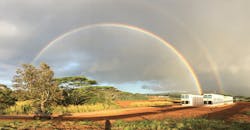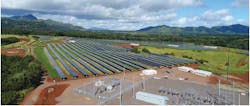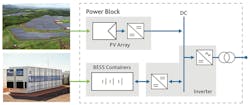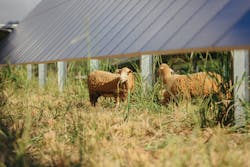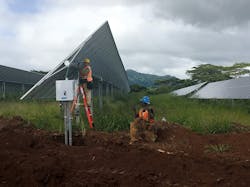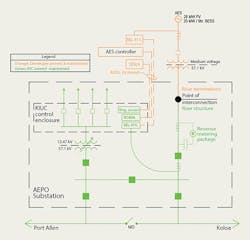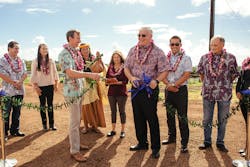An island in the Central Pacific, Kauai is part of the Hawaiian archipelago in the U.S. It is the oldest and fourth largest Hawaiian island, sometimes referred to as the Garden Isle because of its emerald valleys, sharp mountain peaks and jagged cliffs. The Kauai Island Utility Cooperative (KIUC) is the electric co-op responsible for the supply of electrical energy to some 33,000 customer accounts on Kauai.
In January 2019, the world’s largest photovoltaic (PV) peaker plant began providing evening and morning renewable peaking capacity to the grid on the island. The solar-plus-storage system promises to ensure a sustainable future for the island and establish a new model for stabilizing grid-scale renewable energy. Instead of simply augmenting traditional generation, solar-plus-storage sequentially can replace it altogether.
Aggressive Mandate
KIUC has adopted one of the most aggressive renewable goals of any utility in the world: 70% of energy to be supplied by renewable resources by 2030. Additionally, the state of Hawaii has mandated generation must come from 100% renewable sources by 2045. The reason for these targets is as much economic as environmental. Kauai’s existing peak power plants run on oil, a dependence that has strained the economy. As a result of price increases and because fossil fuels must be shipped to the island, Kauai has some of the highest electricity tariffs in the U.S.
In 2010, Kauai’s fuel mix included just 8% renewables: legacy hydroelectric facilities that had been in use since the sugar plantation era. Since then, the island’s renewable portfolio has grown to 54%, in large part because of the proliferation of solar. However, as the solar output has grown, so has the risk of overdependence on a single renewable source of energy. In 2016, KIUC reached its upper limit for additional daytime solar generation on sunny days. The island needed more capacity to provide consistent, reliable peak power, making energy storage essential. Batteries alone were not the answer, as they could not dispatch energy fully during the day when charging. KIUC needed a solution that can provide power when there is no output from solar panels.
The Right Solution
KIUC and AES Distributed Energy together created a solution in the form of large-scale solar generation and battery storage. Owned and operated by AES, this new system enables solar generation to occupy the role thermal generation has played, by varying the output to meet the peak demand. Energy is delivered principally during the early morning, from 6 a.m. to 9 a.m., and in the evening, from 4 p.m. to 10 p.m. Under their agreement, KIUC purchases power from AES at a fixed price based on a 25-year power purchase agreement.
AES designed the system from the ground up to integrate solar and storage fully as a power plant, beginning with a scale-model plant at the National Renewable Energy Laboratory (NREL) in Boulder, Colorado, U.S. The scale-model plant was comprised of a 240-kW PV and 500-kWh battery energy storage system (BESS). NREL’s test bed provided a real-world environment to validate the programmatic and technical elements of the facility prior to installation. At the test bed, AES was able to characterize system response and latency, refine communication mapping, troubleshoot control algorithms, define system component integration and set construction guidelines.
PV Peaker
Located in Lwai, Kauai, KIUC’s PV peaker plant includes a 20-MWac power plant comprised of 28 MWdc of integrated solar PV and a 100-MWh BESS. The PV peaker plant is expected to deliver 53,000 MWh of energy in the first year, roughly 11% of the island’s total energy requirements. This gives KIUC more than 50% of energy consumption from renewable generation.
The PV peaker plant supports three vital scenarios in power distribution:
- It enables solar generation to supply the transmission system while charging the battery system, altering the allocation dynamically as the demand changes.
- It dispatches the power stored in the BESS to the transmission system during evening and morning peak demand periods.
- It can dispatch solar and battery power simultaneously to address spikes in demand or black start as well as restore the transmission system in the event of a system-wide outage. While many other systems, especially AC-coupled systems, coexist, they are not designed to operate together; this PV peaker plant integrates the components into one harmonious system.
To lower the cost of operation and transmit more energy reliably, each power block is on a DC-DC backplane, sharing inverters and transformers. This DC-coupled solution makes solar energy a dispatchable and controllable resource and does this more efficiently than a traditional AC-coupled system. Additionally, the DC-coupled architecture saves on redundant equipment, such as inverters and transformers, while increasing the overall roundtrip efficiency compared to an AC-coupled system. Also, as it requires half as many inverters and transformers, the PV peaker plant is faster to respond to demand peaks, more efficient and more flexible than a standard AC-coupled system. As such, the model sets a new standard for solar-saturated markets that need to time-shift most of the solar generation.
Site Challenges
The site topography presented unique challenges in construction as well as for the future site and plant maintenance. The site selected has four adjacent reservoirs, three dams, multiple ravines, unmade-up roads and steep inclines, with up to 18% grades. Also, prior to construction, it was covered in nonnative Guinea grass that can reach 12-ft (3.6 m) high and grows 18 inches (0.5 m) per week if left unchecked.
As a result, all equipment for this project had to be specially selected and engineered for the site. AES designed shipping containers so the batteries could be transported as standard sea freight and then, once on-site, converted to building materials for the control house. All equipment had to pass higher corrosion-resistance standards to withstand Kauai’s salt air. In addition, unique two-up single-axis trackers were brought in to operate on the site’s steep slopes. At 7.5 ft high (2.3 m), the trackers are twice as tall as standard single-axis units and have elevated wiring, permitting free movement for maintenance operations beneath the array.
To manage the vegetation growth in an environmentally friendly manner, AES contracted with a local rancher to rotate a herd of 300 sheep on the site. This provides the 140-acre (57-hectare) site with a secondary agricultural use, adhering to the State Land Use Commission’s directive to retain agricultural features in Hawaii whenever possible. Over the course of the contract, the sheep will save millions of dollars in labor costs, avoid fossil fuels and herbicides used in traditional maintenance methods, and prevent PV panel damage from mowing and weed growth.
To construct the plant on this challenging site, AES built eight power blocks. Each power block combines a single axis solar array and battery storage unit. The entire facility is capable of producing 28 MWdc and storing up to 100 MWh every day. The plant operates safely and automatically through plant control logic in response to automatic generation control (AGC) dispatch signals issued by KIUC. AES has electrical operations technicians based on Kauai to support the preventive maintenance, repairs, contractor management and commercial management needs of the site. In addition, AES maintains drainage basins, monitors corrosion on equipment and structures, and manages plant settings to keep the battery charge balanced across the plant.
Community Integration
KIUC involved the Kauai community in this project, informing the local community of the benefits and explaining why the design was the best solution to meet the need for more affordable green energy and the goal of 100% renewable sources. It should be noted energy costs from the PV peaker plant fall below the cost of the fossil fuel used in the island’s oil-fired generating plants.
In addition, the PV peaker plant has been designed, sited and integrated into the landscape on otherwise fallow land, and it requires no additional transmission lines. With unified support and a development process that incorporated public feedback, AES and KIUC were able to progress from the agreement stage to operation in less than two years — setting a new standard for development agility and stakeholder partnership in the process.
A New Model
In January 2019, the AES Lwai PV peaker plant began providing evening and morning renewable peaking capacity to the transmission system on the island of Kauai. The solar-plus-storage system promises to ensure a sustainable future for the island and establish a new model for stabilizing grid-scale renewable energy. Instead of simply augmenting traditional generation, solar-plus-storage sequentially can replace it altogether.
It is remarkable — by obtaining fixed pricing for dispatchable solar-based renewable energy, backed by a significant battery system — the overall cost of this PV peaker plant is about half that required for a basic direct-to-grid solar project a few years ago. This project is now expected to deliver power to the island’s electrical infrastructure at a cost significantly less than that of the current cost of oil-fired power, which will help to stabilize the tariff rates for KIUC’s customers.
This project will remove the annual economic cost and environmental impact of 3.5 million barrels (556 million liters) of oil. KIUC and AES already have partnered on a second project that includes AES’s 19.3-MW-solar-plus-70-MWh-battery energy storage facility, currently under construction on leased land from the U.S. Department of Defense within the Pacific Missile Range Facility Barking Sands Naval Base. AES expects this solution to become a model for solar-saturated markets where it is necessary to time-shift most of the energy generated.
The KIUC PV peaker plant establishes a new model for renewable energy. By addressing the dispatchability problem, it solves the inherent compromises that have relegated solar to an ancillary role in power distribution. With a working model that is more affordable, flexible and sustainable than a fossil fuel plant, solar can become a primary generation source.
Sidebar: A More Stable Grid with DC-DC
The Kauai photovoltaic (PV) peaker plant converts energy dramatically faster than the traditional supervisory control and data acquisition (SCADA) systems used for plant management. Whereas traditional SCADA systems have a 1-sec response time, the PV peaker plant controls coordinate hundreds of devices for system-level response within 50 msec. This is because the plant’s 1500-V class inverter runs at a fixed voltage with distributed DC-DC conversion and advanced device communication. By feeding DC-DC converters on both the battery and PV subsystems into a bidirectional inverter, the system can connect the solar panels to the same DC bus as the batteries.
Within normal operations, the batteries can charge without pulling any energy from the grid. In addition, the unique design enables PV to flow onto the grid through the inverter or directly to the BESS for storage. It also enables a combination of PV and stored energy to flow simultaneously through the inverted and onto the grid. Battery charging and discharging is managed automatically by the system controls, which are set to react to the PV system voltage. The result is a more responsive, more stable grid.
About the Author
David Bissell
David Bissell is president & CEO at Kauaʼi Island Utility Cooperative. Under his leadership, KIUC has increased renewable energy sourced generation from 8% to more than 50% since 2010. Mr. Bissell was among 11 utility industry leaders who were asked to serve on the Puerto Rico Electric Power Authority’s newly formed Transformation Advisory Council.
